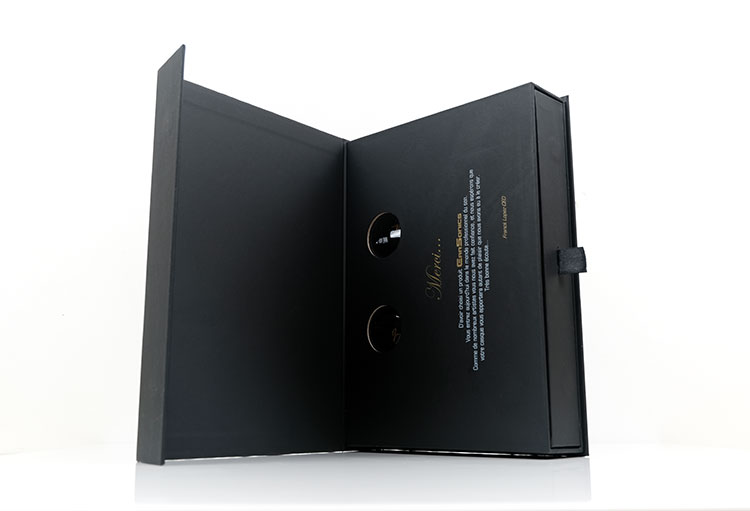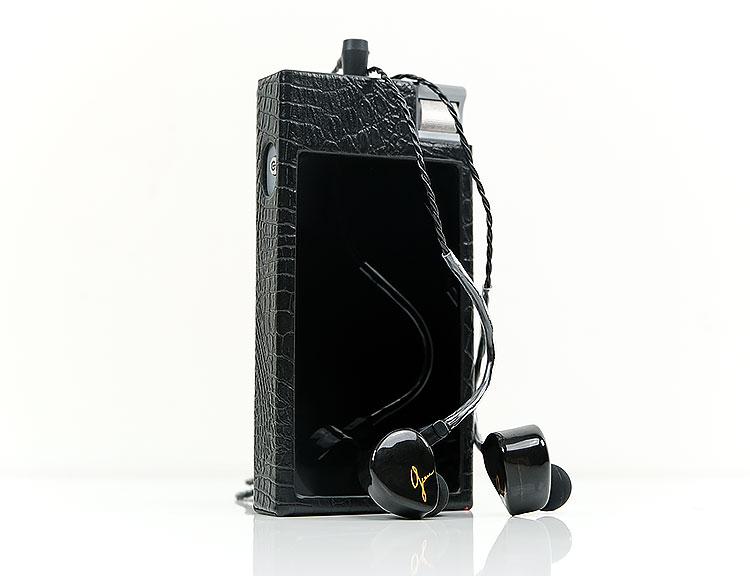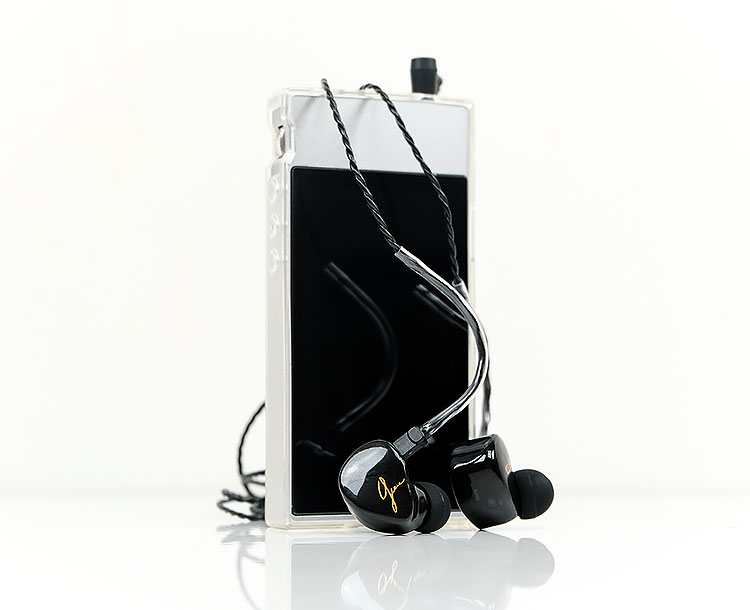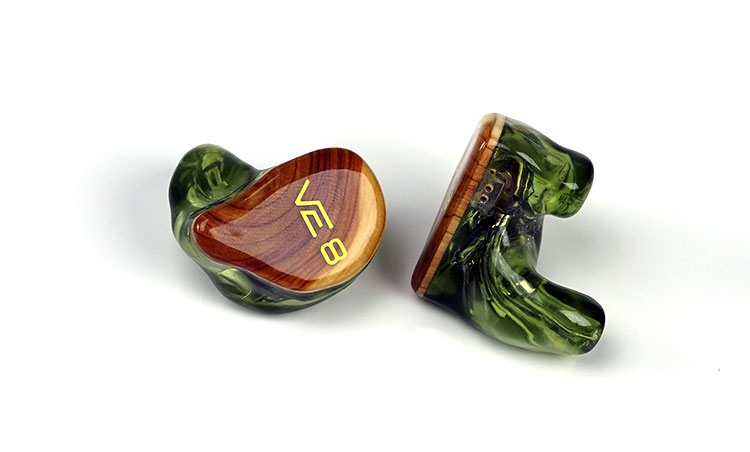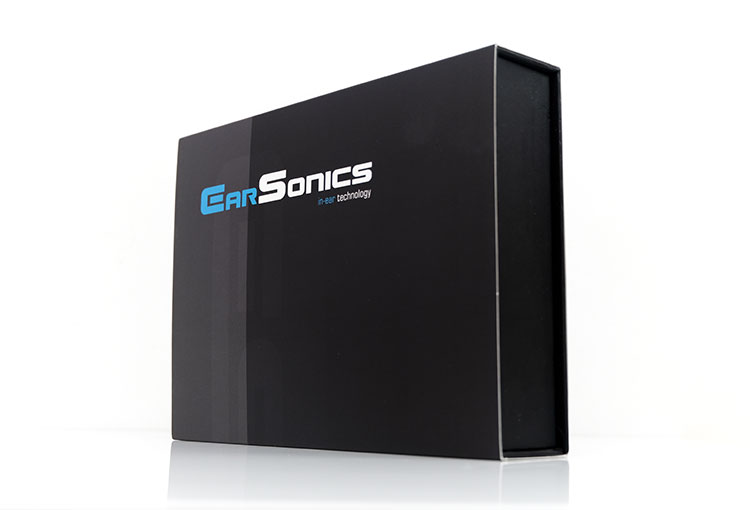Sound Impressions
Summary
The difficulty with describing the Grace is how much emphasis do you put on a signature with the stock cable or do we tell you how much potential it has with a different cable which would require a little bit of investment. I say this because Grace really sounds like a different monitor with a good quality cable attached.
With the stock OFC 4-wire cable, the Grace delivers a slightly dark, warm and soft sounding presentation. There is a slight mid-bass emphasis with a rich and detailed instrumental texture and a forward vocal presence.
Bass is thick, to the warm side and slightly forward sounding. However, it is a touch soft and not that aggressive. This is an even-harmonic biased tuning with plenty of body but not a huge amount of power or impact.
Mids instrumental timbre is warm and erring to the euphonic side for vocals. The Grace stock vocal performance is excellent for mid-pitched female vocals which are resolutely smooth and detailed sounding and slightly to the fore.
Treble is relaxed and forgiving without any harsh peaks but slightly lacking in air and sparkle. With the stock cable, percussion timbre without that sparkle can lack a little presence and bite with feistier rock and metal tracks that I sometimes crave for.
Cable Swapping
Once you change cables, however, the synergy is much better with a far more impressive and punchier response. Particularly so with the Thor II from Effect Audio on the 4-wire level and the 8-wire OC Studio Orpheus MK5.
OC Studio Orpheus MK 5
The Orpheus MK5 did a marvelous job opening up the soundstage and adding an additional level of presence to Grace’s vocal presence and clarity. The low-end was also much tighter though it is still not necessarily the punchiest of performances. The treble is still a little laid back but this time percussion timbre has a little more snap to it and does not sound as soft as with the stock cable.
Effect Audio Thor II
The best pairing was the silver 4-wire Thor II which does beg the question just how good the 8-wire might be. The most important change was a punchier low-end and a healthier injection of treble presence. It is not quite as meaty sounding as the 8-wire Orpheus MK5 but did sound a little quicker and more balanced to my ear. The staging was also taller and wider with better instrumental clarity and a bit of warmth from the stock cable sucked out giving the Grace a much more natural or accurate tone.
Soundstage
Stock Cable
With the stock cable, the Grace projects excellent depth and width though it lacks a little in top-end sparkle and air. Instrumental separation is good though at times that mid-bass warmth and the slight drop in upper mids/lower treble quantity robs the staging of a little openness. Imaging cues are also not quite as immediate as they could be.
I wouldn’t class this as a veiled presentation but the softness and lack of dynamic range do not allow the Grace to breather quite as much as I know it can.
Thor II
With the EA Thor II cable attached I got much better headroom and air from Grace’s soundstage. Depth remained about the same but the tighter low-end created a more open sounding bass response. That cleaner midrange instrumental harmonic balance also delivered better spacing for vocal presence, particularly male vocals which felt they had much more presence than before.
Leonidas II
If you really want to push the staging to the limit then the pricer EA Leonidas 2 will give you the most holographic presentation of the three cables tested with the Grace. With this cable, Grace is not as punchy sounding as the Thor II with less perceptible low-end power and presence but it does sound more open in the mids.
Synergy
Efficiency
The Earsonics Grace is rated at 26.6Ω and 119dB sensitivity. It should be very sensitive and easy to drive however in our real world testing we found it required a little more juice than the specs on paper might suggest.
That is not to say it is hard to drive in absolute terms as it sounded just fine from my smartphone for general levels of loudness. This is more contextual compared to the ratings of other top-tier monitors.
For example, using a Lotoo PAW Gold Touch reference DAP in 3.5mm balanced with the stock cable we were hitting around 50-52 on the volume in low gain compared to the 50-52 setting on the 20Ω/120dB Vision Ears VE8. That is some gap for a 6Ω and 1dB difference.
With the AAW W900, we almost had the exact same volume settings to get parity on the same setup and this is a 16Ω and 107dB hybrid monitor. My gut instinct tells me that in real world terms this is closer to 110dB than 119dB.
Noise
The performance with high noise floors using the Grace is excellent though not quite on the level of the RE2000SE or the AAW W900. I tend to find those dynamic-driver infused monitors tend to have a sensitivity level that negates most noise floors compared to BA designs.
The Grace, however, is much better on noise with the likes of the Cayin N8, ALO Audio V5, and the Oppo HA-2SE compared to the Vision Ears VE8, Campfire Audio Andromeda and the EE Phantom. I would class the Grace therefore as a medium sensitivity IEM based on volume demands and noise performance.
Pairings
If you are going to stick with the stock cable then I suggest you go with a neutral and clean source or amp to pair with the Grace.
As an example, we found the reference DAP tones of the Lotoo Paw Gold Touch and the cleaner mid-fi signature of the AK240 to yield a more balanced signature than the slightly warmer iFi xDSD.
DAPs such as the FiiO X3iii produce a bloated and slow sound that didn’t really show off what Grace can do either and the tube output of the Cayin N8 was much too romantic and lush to really satisfy with the stock cable.
Select Comparisons
All comparisons were done with stock cables. Sources include Lotoo Paw Gold Touch, iBasso DX200 (AMP 1), Sony NW-WM1Z. Portable amps include ALO Audio V5, Chord Mojo, and FiiO Q5. All tracks used are FLAC 16BIt/44.1K.
Vision Ears VE8
€2330
Technical
The VE8 is Vision Ears Flagship custom Monitor. You cannot get it in a universal form factor currently. VE’s only universal monitor is the Erlkonig and it is much more expensive. The VE8 comes in close to Grace’s price point at €2330. Whilst one is a custom and the other is universal we cannot give you a fair fit and comfort comparison though the VE8 is a little heavier than the Grace.
The VE8 is an 8 BA driver monitor with 2 for the lows, 2 for the mids and no less for 4 for the treble. The Grace 10 drive configuration is 4 for the lows, 4 for the mids and 2 for the highs. The VE8 uses a horn principle designed nozzle with recessed bores whereas the Grace uses a direct multi-bore design. The VE8 is rated at 20 ohms with a sensitivity rating of 120dB compared to the Grace’s 26.6Ω and 119dB.
Efficiency
Both I would classify as easy to drive but the VE8 is much more sensitive in actual tests we did than the Grace despite the 1dB difference on paper. Using the Lotoo PAW Gold Touch reference DAP in low gain 3.5mm there was easily a 10-step gap in the volume (52 vs 62) to achieve relative parity between the two monitors.
On the flipside, the Grace does seem to be marginally more tolerant of noise and background hiss. It is dead silent on both the Touch and much lower in noticeable noise on the Cayin N8 than the VE8. Portable tube amps are an option also with the Grace such as the V5 from ALO Audio which is almost silent in low gain.
Performance
The VE8 is a little more V-shaped than the Grace with more sub-bass and treble presence, particularly its lower treble performance. The Grace is a touch on the darker side with less top end air and a more laid-back treble.
Bass
The VE8 has more sub-bass presence and power compared to the Grace which has a more forward mid-bass quantity and warmth. Guitar work on the VE8 is powerful with excellent bass fundamentals though slightly more neutral in tone than the softer richer Grace signature.
Mids
Vocal positioning on both is similar for male vocals though the VE8 has a slightly more forward emphasis on female vocals. Changing the stock cable on the Grace will bring deliver a more vivid female vocal performance. The stock cable seems to just dull it by comparison. Timbre though is slightly different primarily because of the VE8’s more forward lower treble emphasis which throws in a bit more odd-harmonic emphasis.
The Grace, by comparison, is the smoother and warmer sounding. It will lack a little bite and clarity compared to the VE8 in terms of instrumental and voicing timbre but has a bit more body and focus. There are times I prefer the Grace vocal performance, particularly with those ‘willowy’ folk type performers such as Annette Askvik.
Treble
Treble on the VE8 is more forward sounding. The lower treble is perceptibly more aggressive and snappy sounding compared to the laid-back and darker sounding Grace. Both have excellent detail actually so some of that is Grace’s stock cable which dulls the dynamic range a bit for me. Switching to something like the Ares II from EA will open it up a bit more.
AAW W900
SG$2,849
Technical
The W900 we have here is a custom version but you can get a universal version for SG$1,999 which is a little lower than the €2000 price of the Grace. As a consequence, we will not be making any direct remarks on the passive isolation gaps between the two but we can say that Grace is much lighter and smaller in the ear than the W900.
The W900 is a 9-driver monitor but this is a hybrid design with one 9mm Dynamic Driver and 8 Balanced Armature Drivers as opposed to Grace’s all BA 10-driver configuration. The W900 also uses a slightly more complex 4-way crossover compared to the Grace 3-way crossover design. The additional crossover is for a physical low pass Filter on dynamic driver bass response.
Efficiency
The W900 is rated at 16Ω and 107dB but despite the lower levels of sensitivity and impedance, it seems both it and the Grace seem comfortable at similar volume levels. True, the 26.6Ω rating of the Grace means it should be the slightly harder to drive of the two however the sensitivity rating gap feels far less than the on-paper specs would suggest (107 vs 119dB). In all honesty, if I had not read the specs I would have placed the Grace closer to about 110dB from the results of our listening tests.
For noise, the W900 is just marginally the better performer but again, the gap is just minimal or almost negligible. With portable amps like the ALO Audio V5, the W900 was dead silent and the Grace only had a slither of low-grade noise that was barely noticeable.
Performance
Tonally, there are a few differences to these two monitors. The W900 is fairly coherent and in some ways quite smooth sounding also. However, it has some additional upper treble forwardness and a lower treble dip that offers a bit more air and headroom that the Grace but less body. Percussion on the W900 has a good edge and presence but might come across as a bit thin sounding and lacking in authority.
The Grace pulls it back and its treble not as airy but has the more pleasing timbre and body. Some might find it too soft and forgiving, others might enjoy that solidity over the lack of sparkle. Upgrading to a silver cable such as the Thor II from Effect Audio will bring out a bit more treble presence and air on the Grace that closes the gap without thinning out the harmonic balance.
Despite have a dynamic driver the W900 sounds a bit more neutral to me on the low-end and not as warm or thick sounding compared to the Grace. The instrumental timbre on the W900 mids is also slightly more neutral and cleaner sounding whereas the Grace continues to sound richer and thicker with more presence. Vocal positioning in similar though tonally the W900 vocal timber is a little thinner and cleaner than Grace’s richer tone.
I would take the Grace personally for harder hitting rock. With a good cable, guitar notes sound meatier and more authoritative than the W900. I would veer to the W900 if I wanted a little more a reference sound and treble sparkle.
Hifiman RE Silver Edition
$1500
Technical
The RE2000 SE is the cheaper version of the older RE2000 Gold from last year. This is a single 9.2 mm Topology Dynamic Driver universal monitor with an SRP of $1500. Now as I write this Hifiman have been running a sale of the silver edition now for about a month at $799 which is just a crazy deal if you ask me.
In terms of build, the RE2000 SE uses a slightly heavier but more robust aluminum alloy compared to the lighter acrylic of the Grace. The Grace is actually a little bigger but you wouldn’t notice that right away due to the odd dimensions of the RE2000 SE. However, the Grace has the better fit with that more traditional slightly contoured 3D design slotting in much easier into the ear. The RE2000 SE dimensions still prod away at my outer ear a bit too much though less so than the older heavier gold version.
Since both are universal both are supplied with a range of tips for comfort and seal. Here I find the RE2000 SE selection quite lacking in comparison to the Grace. The lack of foam tips is a drawback in choice compared to the Grace’s single, dual and foam selection. The RE2000 SE does have a triple flange option which I tend to use but in terms of a good seal, the Grace has the edge.
Efficiency
The RE2000 SE is rated at 60Ω and 103dB and yes, easily the harder to drive and the less sensitive of the two. In our PAW Gold Touch reference DAP testing both achieved volume parity around 10-15 digital steps apart in low gain 3.5mm output. The RE2000 SE needs a good quality source and amp stage to sound at its best.
Sure, it will be far more resistant to noise so it will place nice acro0ss a wide range of higher noise floors such as the ALO Audio V5 and Cayin N8 but the Grace is almost negligible in that respect and much easier to drive.
Performance
Tonally, the RE2000 SE is a little more V-shaped than the Grace though its instrumental timbre is possibly the more accurate and cleaner of the two.
Bass
Neither have an overly dominant low-end thankfully but they do sound quite different for bass. You get that distinctive dynamic driver low-end signature and decent sub-bass presence with the RE2000SE whereas I find the Grace to have a little more mid-bass warmth and quantity.
That mid-bass warmth of the Grace combined with a slightly milder lower-mids dip compared to the RE2000 SE delivers a richer, warmer and more forward sounding instrumental timbre and positioning.
Mids
The RE2000SE is not cold, its relatively natural sounding in its own right also but that more extreme lower-mids dip delivers something more neutral, more recessed and slightly further back in the mix. It creates the perception of a larger soundstage compared to the Grace though at the cost of some vocal presence.
The Grace has a smoother more inviting male vocal tone than the RE2000 SE or pretty much any vocal around the 800Hz to 1k area. Female vocal beyond 2k have a similar positioning with both showing a more forward presence for higher pitched vocals 1-2k onwards. Here some might prefer the more neutral vocal timbre of the RE2000 SE compared to the softer warmer Grace.
Treble
The RE2000 SE has the more forward and cleaner sounding treble response. It not a brash or bright signature but it is not quite as laid back or as warm sounding as the Grace. That additional presence shoots in a little brightness into the harmonic balance that gives percussion a bit more bite, guitars a little more edge and generally a more neutral timbre. The Grace has a lift but is relatively minor in comparison without a decent cable. The stock cable tends to dull the Grace top-end a bit too much.
Our Verdict
The Grace is the best Earsonics monitor I have heard to date and is probably the best demonstration yet of that smooth and forgiving Earsonics house sound. This is a full-bodied natural sounding flagship monitor with a strong emphasis on musicality.
However, it is a monitor that deserves a better class of cable to hear it at its best. The stock cable robs it of some dynamic range and openness. You do not have to necessarily have to spend big to get a great performance though.
The $250 OC Studio 8-wire Orpheus MK5 will really do a great job opening up the soundstage and creating some welcome headroom from the Grace but it is the Thor II that delivers a bit of aggression and treble sparkle where I think the Grace really finds its feet.
Overall, the Earsonics Grace is going to appeal to those who like their music free-flowing and enjoyable rather than analytical or rigidly neutral and as such presents a competitive option at the top-tier level.
Earsonics Grace Technical Specifications
- Sensitivity: 119 dB/mW
- Frequency response : 10 Hz -20 kHz
- Impedance: 26.6Ω
- Driver: 10 balanced armature drivers, HQ 3-way passive crossover with impedance corrector


